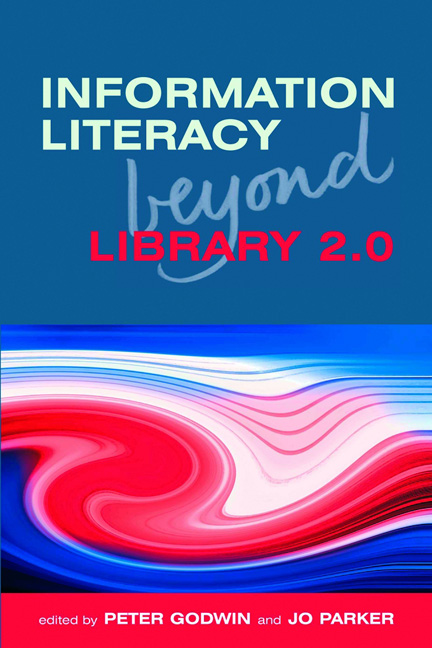Book contents
- Frontmatter
- Contents
- Contributors
- Acknowledgements
- Introduction
- PART 1 RECENT DEVELOPMENTS IN INFORMATION LITERACY AND LIBRARY 2.0
- 1 Library 2.0: a retrospective
- 2 Information literacy and Library 2.0: an update
- 3 The story so far: progress in Web 2.0 and information literacy
- 4 The changing web: sites to social
- 5 Web 2.0: from information literacy to transliteracy
- 6 Informed learning in online environments: supporting the higher education curriculum beyond Web 2.0
- PART 2 CASE STUDIES
- PART 3 WHAT IT MEANS FOR INFORMATION PROFESSIONALS
- Index
5 - Web 2.0: from information literacy to transliteracy
from PART 1 - RECENT DEVELOPMENTS IN INFORMATION LITERACY AND LIBRARY 2.0
Published online by Cambridge University Press: 09 June 2018
- Frontmatter
- Contents
- Contributors
- Acknowledgements
- Introduction
- PART 1 RECENT DEVELOPMENTS IN INFORMATION LITERACY AND LIBRARY 2.0
- 1 Library 2.0: a retrospective
- 2 Information literacy and Library 2.0: an update
- 3 The story so far: progress in Web 2.0 and information literacy
- 4 The changing web: sites to social
- 5 Web 2.0: from information literacy to transliteracy
- 6 Informed learning in online environments: supporting the higher education curriculum beyond Web 2.0
- PART 2 CASE STUDIES
- PART 3 WHAT IT MEANS FOR INFORMATION PROFESSIONALS
- Index
Summary
Introduction
This chapter is divided into two parts. In the first part literacy is discussed in terms of its ‘functional’ nature, as it provides the basis for social interaction, be it in print or digital worlds. The second part presents the view that there is a dynamic relationship between literacy and the information environment in which it operates. This relationship, which defines the functional attributes of literacy, is mapped onto a timeline that illustrates the shift from print to web environments. As the title of this chapter suggests, transliteracy is promoted as the literacy that is needed to function in a Web 2.0 world. This is because, as current technologies offer new ‘applications of established processes of knowledge construction and sharing’ (Thomas et al., 2007), the competences underpinning these processes need to be updated. Hence the need to move from information literacy to transliteracy. For those who are not familiar with it, the term ‘transliteracy’ was coined by Professor Thomas to describe ‘the ability to read, write and interact across a range of platforms, tools and media from signing and orality through handwriting, print, TV, radio and film, to digital social networks’ (Thomas et al., 2007). The two main practices of Web 2.0, namely the reorganizing and sharing of information and knowledge that are undertaken collectively (Witteman and O'Grady, 2008), are discussed here in terms of their impact on web users, turning them from consumers into ‘produsers’ of information (Bruns, 2008a, 2). The concept of produser is analysed later on. For now, it suffices to say that this is a compound term derived by the merging of ‘producer’ and ‘user’. The exclusion of Web 3.0 from this timeline is deliberate, as we need to establish the functional literacy operating in a Web 2.0 environment before we can turn our attention to the functional literacy associated with the semantic, sentient, mobile and virtual environments that characterize a Web 3.0 world (O'Reilly and Battelle, 2009, 2).
Functional literacy
Whilst to be functionally literate means simply to be an ‘active participant in society’ (Ipri, 2011), it is not surprising that functional literacy means different things in different contexts. In its broad social function, literacy capitalizes on individuals’ potential to foster the collective development of local and global communities (UNESCO, 2008, 1).
- Type
- Chapter
- Information
- Information Literacy Beyond Library 2.0 , pp. 53 - 64Publisher: FacetPrint publication year: 2012



